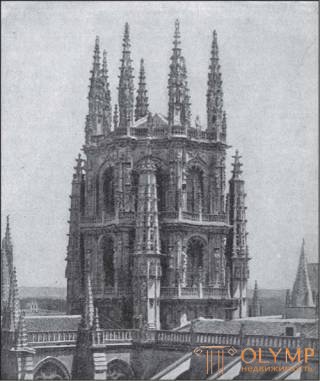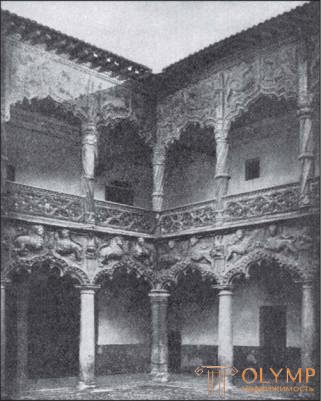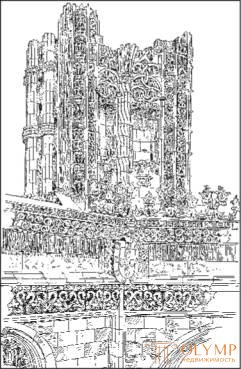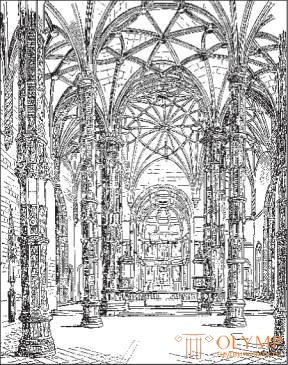
Architecture
During this epoch, the Iberian Peninsula, due to its geographical position, which meant it to great world-historical discoveries through travel, sought to transient world domination. In order to satisfy artistic needs, which in both Spain and Portugal arose along with rapidly acquired wealth, foreign artists and works of art, Dutch, German, and Italian, were attracted primarily, and the generation of local artists gradually grew from their examples. At the turn of the XVI century. Everywhere, a certain autonomy awakened, primarily in the field of architecture, which developed a mixed decorative style, magnificent and magnificent, but without the makings of durability.
In Spain, the architecture for the longest part of the XV century. It moved along the old Gothic ruts, although in some places it was influenced by the Moorish traditions. The first purely Italian monument of the early Renaissance on Spanish soil, created by an Italian, perhaps, as Justi believed, Andrea Sansovino, is the tomb of the great statesman and Cardinal Mendoza who died in 1495 in the cathedral in Toledo. Until that time, only sporadic responses of the early Italian Renaissance were found in Spanish buildings. Now they are combined with the Gothic and Moorish motifs of jewelry woven into the jewelry, or chased, style (plateresko), which reached full bloom only in the XVI century. In general, even the second half of the 15th century is here. It belongs to that rich late Gothic, which the Spaniards themselves call estilo florido.

Fig. 357. The tower above the center of the cross of the cathedral in Burgos. According to Junggendel and Gurlitt
The majestic cathedral in Burgos towered even without a tower over the roofs of the ancient city of Sid. German craftsmen were called to decorate his appearance and give it a final finish. Hans from Cologne built between 1442 and 1458. two magnificent western towers, the through spitzs of which resemble the same ones intended for Cologne, but coarser and heavier in appearance, and in the Arabic style (cf. t. 1, fig. 646) are decorated on some floors with Christian inscriptions as ornamental stripes. Instead of the famous tower over Sredokrestiy (crocero, cimborio), which collapsed in 1539, a new, extremely rich, “jewelry style” was erected, the decorations of which were hardly conceived by Hans from Cologne (fig. 357). His son Simon of Cologne built, starting in 1482, the Capilla del Condestable behind the main throne, a real front room in a “flaming” style, with jagged blades along the edges of the arch of the vault and hollowed out leaves to decorate profiles, office columns and gims, and then He graduated from the Carthusian monastery of Miraflores near Burgos, conceived in plan in 1454 by his father, whose single-nave church with ornate vaults is typical of its kind.
In Valencia, in the same way, the German or Dutchman Juan Frank in the first half of the century decorated the cathedral with a beautiful eight-sided “crocero”, richly decorated in the style of open-work stone carving, without changes in the “flaming” style. In Valladolid, the Cathedral of San Pablo (after 1463) received a magnificent facade in Cologne-Castilian style. The Cathedral in Toledo was supplied in the XV century. new portals. Three doors of the western facade (1418-1450) are made by Spanish builders in the style of lush Gothic. The magnificent gates with lions at the southern end of the transept were built approximately between 1459 and 1467. Again, the Dutchman, Brussels Annequin de Egas (probably Jan van Aikens), in the luxurious gothic style of the time. Anneken’s successor as architect of the Toledo Cathedral was his son Enrique de Egas (died in 1534), who worked in various cities in Spain, transforming the estilo florido into estilo plateresco. Another Flemish, João Gwas (You), participated around 1459 in building the cathedral gate with lions, and after 1476 built for Ferdinand and Isabella the monastery church of San Juan de los Reyes in Toledo, a single-nave hall system church, but equipped with a transept and representing a somewhat superficial transition from late Gothic through the chased style to the architectural style of the Renaissance.
A new large church, to which Spain was enriched in the 15th century, was a seven-cathedral church in Seville (1403–1507), the builders of which are unknown. Being at the base of the largest among the Christian churches, it forms in the plan a rectangle without protrusions. The transept and the middle nave, above which the cimborio rises in the form of a dome, are of the same width and height, four inner side naves of equal height slightly lower and narrower than their rows of chapels into which the fifth and sixth aisles and the direct choir have passed. Beamed pillars, decorated with small capitals and without typicality, with wreaths of leaves, mightily aspire upwards to high, smooth cross vaults, which are equipped with a fairly rich system of ribs only above the medium cross in four adjacent fields. The interior of the cathedral makes a sublime, solemnly sad impression. According to the widely spread exterior of the building, however, it is completely unnoticeable that it contains a high Gothic cathedral.

Fig. 358. Courtyard of the Palace Infantado in Guadalajara. According to Junggendel and Gurlitt
Churches XV century. hall systems are found in northern Spain. The plan of the church in Medina del Campo, for example, whose ten arches are decorated with a rich network of ribs, consists of nine equal squares, of which in the middle of the east side one protrudes forward to form a choir chapel.
Among the Spanish secular buildings, the Infantado Palace in Guadalajara (Fig. 358), built after 1461 by João Gwas, is one of the most magnificent works of the late Gothic style. His palace in its unaffected parts is a model of the combination of Gothic and Moorish motifs, which lacks only the elements of the Renaissance to become the plateresco style. These elements of the Renaissance appear for the first time in the lined up in 1480–92. Enrique de Egas Collegiate of the Holy Cross in Valladolid, an institution founded by Cardinal Mendoza. In the simple courtyard we see still Late Gothic forms with octagonal pillars and wide semicircular arches; the upper tiers of the outer buttresses of the facade are already equipped with pilasters of the early Renaissance. Only in the portal of the Hospital of the Holy Cross in Toledo (1504–1514), Egas moved to a style that, although still containing the echoes of the Gothic, was essentially Italian. Yusti said: "The fantasy, spoiled by the Gothic florido and the fine fabric of the Mudejar style (cf. Vol. I, p. 772), is covered here by Italian influence, but the Gothic shadow shines everywhere."
As far as the Spanish builders used the Gothic style in a cleaner form in the 15th century, for example, the elegant courtyard Casa de la Deputacion in Barcelona and the famous luxurious building of the San Gregorio College in Valladolid (1488–1496) show. Only one motif of the keel-shaped arch dominates the portal, built like a tower; stone spitz hang from the arches; statues stand under canopies; There is not a single piece of surface that is not decorated. But in general, the impression is not that of the Gothic, but rather plateresque style. Finally, follow the exchange. The most famous exchange of Palma and Valencia. "Casa Lonha" in Valencia (1482-1498) is a picturesquely dissected building outside, decorated with an elegant loggia, and inside is a large delightful hall, supported by powerful twisted stone columns. Spain also took from the late Gothic what she could give. Forms of the Renaissance, in which the chased style has now wholly unfolded, entered into force in Spain, but not earlier and no later than in France.

Fig. 359. The upper floor of the capellas imperfeistas in the Portuguese monastery in Batalha. According to Gaupt
Portuguese architecture developed in the same direction as Spanish. Parallel to the beginnings of the chiseled style in Spain, go to Portugal (from 1480) the beginning of the style, which by the name of the great King Manuel I (1495–1521) was called arte Manuelina. Along with the Moorish elements developed in this style of "Manueline", even stronger elements in Portugal than in the minted style of Spain after the return of Vasco da Gama from the East Indies (1499) even Indian elements appear, and although the great Italian master of early Renaissance Andrea Sansovino, drafted in 1491 by John II in Lisbon, he worked in Portugal for many years, the real elements of the Renaissance in this magnificent, mixed style appear for the first time only in the 16th century.

Fig. 360. The interior of the monastery church in Belem in Portugal. According to Gaupt
An idea of the development of Portuguese sculpture of this time gives the monastery in Batalha. She joined the Gothic church on the east side at the beginning of the 15th century. a magnificent, unfinished large octagonal chapel (capellas imparfeitas), which Degio considered the most prominent round church building along with the Cathedral of Our Lady in Trier (see fig. 265 and 266). Its lower tier represents, as Haupt said, “an English type so clearly expressed that one cannot doubt the authorship of an Englishman.” Only after 1491 they began to build further the upper tier (fig. 359) in a richer mixed style, which Portuguese architect Hoao de Castillo brought everything closer to the Renaissance style until the building was abandoned. Notable here are the pillars of Indian bundles of round columns (without rims and flutes) and the magnificent portal of the connecting corridor leading to the church, which is an example of that rich through-stone work with all sorts of zigzags and weaves that hardly resembles lace as much as here. The San Francisco Church in Évora is remarkable for its simple late Gothic style, and the slim, small Christ Church of the hall system in Setubal (1495) with its twisted columns and netted ribs braided like a rope makes a peculiar and attractive impression, but the monastery in Belem, undoubtedly entirely from the 16th century. , unleashes in all its brilliance Manuel's fantastic style of time. The interior of the high church of the hall system (fig. 360) with its extremely thin, cross-sectioned, octahedral pillars, with rich sculptural decorations (moreover, the ribs of the arch like palm branches grow from fantastic capitals of these pillars) do not impress either the Gothic or the Italian church; but if you look up at the magnificently interwoven mesh vaults, then you still feel that you are still standing in the late Gothic church. Even more wasteful, Hoao de Castillo showered with all the gifts of the Manueline style a cloister, in which Renaissance ornamentation appears more clearly on the columns, pillars and inner surfaces of the vaults. However, the most peculiar Portuguese work of such a mixed style is the choir of the Knights of Christ in Tomar (1523), on the outer sides of which, along with Indian and Italian motifs, as the last shoots of the Gothic, those mentioned above forms imitating trees and branches, which in the north are more often appear only in the XVI century. (see fig. 345).
Horseshoe arches and other features of the Moorish style in secular buildings lasted longer than in the church. In Évora we find a mixed style with horseshoe-shaped arches not only in the hunting castle of Sempre Naiv, but also in the houses of the townspeople. But above all in the more ancient, dating back to the 15th century, parts of the famous royal castle in Sintra one can see the above-mentioned clearly expressed mixture of Moorish and Gothic forms, the combination of which cannot be viewed simply as a mesallianse.
Sculpture
In the fine arts of Spain XV. more distinctly than in architecture, the style of the east coast, facing Italy, differs from the style of the Castilian highland, to which the Andalusian south adjoins. On the east bank, as Justy showed, sculpture, which in comparison with the Renaissance art in Italy seems backward, develops, but adjacent to the style of the Pisans (see fig. 291-295), it nevertheless strives for free beauty. This sculpture flourishes mainly in the reliefs and standing figures of altar sculptures (retablos), always inside the Gothic frames. Its main centers are Valencia, the city of Lleida and Tarragona. Its main master is Pedro Juan de Tarragona, whose best works are the beautiful sides of the high altar of the cathedral in Zaragoza and the magnificent altar of the cathedral in Tarragona (1426).
In Castile, Andalusia and Portugal dominated, on the contrary, more sharp, dry, but realistic style of the north. The sculptural works of Enrique de Egas and Johann German (Juan Aleman) on the Lion Gate in Toledo, in the words of Justy, give the impression of “Rogier van der Weyden, translated into stone”. The most outstanding altars of this style are in the Seville and Toledo cathedrals. The South German master, who began in 1482 installing a cut of wood and covered with rich gilding Seville altar, more than 40 meters high and enclosing 44 fields with images from the life of the Savior, was called Dhankart. He was succeeded in 1497 by Juan Fernandez Alemán. This gigantic work is too inaccessible for viewing as a whole to please. In some parts, it contains a lot of features of very vital art. The master who compiled about 1500 a project dedicated to the life of the Savior, carved out of wood and richly gilded and painted "Retablo" of Toledo Cathedral, was, after Ponza, again Enrique de Egas, who was helped by Pedro Gumiel. The third large altar in the Cartesian church in Miraflores, near Burgos, introduces us to one of the best Spanish sculptors, Gilles de Silo, who made this building decorated with statues and reliefs with rich gilding together with Diego de la Cruz in 1486–9999. In the middle of a huge round crown of angels, the emaciated suffering figure of the Crucified stands out sharply, at whose feet stand John and Mary.

Fig. 361. The tombstone of Juan II and his wife Isabella by Gilles de Silo in the church in Miraflores. From a photo of Laurent
Gilles de Silo was first and foremost a sculptor of gravestone sculpture. Gill’s oldest work of this kind is considered to be a skilful monument in its simplicity to Bishop Alonso de Cartagenus (died in 1456) in the chapel in the name of the Visitation of the Virgin by the Holy Virgin. Elizabeth, in the cathedral of Burgos. Richer is the tombstone in the niche of Infanta Alonso (died in 1470) on the northern wall of the Cartesian church in Miraflores. The masterful work of Gilles is a marble tombstone to King Juan II and his wife Isabella (fig. 361) in the same church, executed between 1486 and 1493. The royal couple rests on a rectangular tombstone, whose decorations in the form of niches, canopies, lions, figurines and reliefs defy any description. As a sculptor, along with Gilles de Siloye, only Pablo Ortiz should be mentioned, who in 1489 performed the monument to Don Alvaro de Luna and his wife in the chapel of Santiago in Toledo Cathedral. At his feet and near the head of a knight, warriors in chain mail are kneeling, his wife has monks and nuns. Burgundy-Dutch art was a successor to this work.
Along with stone and wooden sculpture, plastics in metals flourished mainly in the form of jewelry. The style of argy-like Spanish bush, these tower-like canopy, worn on the feasts of God's Body, first followed the great architecture, and then it was ahead. In the first half of the XV century. The focus of this jewelry was Catalonia. The oldest and most beautiful work of this genus, the gold artwork master Francisco de Azis Artany (1430-1458) in the Cathedral of Gerona, represents the rich Gothic style of the first half of the 15th century. “In the harmonious, thoughtful proportions” (according to Yusti). But by the end of the century, the Gothic forms in this area became softer and more complex up to the time when they, having perceived the motifs of the Renaissance, switched to the already described “jewelry” style (plateresco), which received life and name from the jewelry art.
Painting
Walking on the trap, on the one hand, in Italian, and on the other - in Dutch art, Spanish painting in the XV century. gradually became on its feet. Among the researchers to whom we owe our knowledge of Spanish painting of the 15th century, let's call Bermudez, Stirling and Passavan. On the contrary, the history of Portuguese painting, despite the names of early artists, learned from oblivion by Count Rachinsky, begins only in the 16th century.
Among the Italians who spread the style of Giotto and his school in Spain, it is necessary to name Gerardo Starnin (the end of the 14th century) and Dello Delly (the first half of the 15th century); from the Dutch XV century. Jan van Eyck himself was on the Iberian Peninsula, while others, such as Rogier van der Weyden, Memling and Gerard David, created significant works for Spanish and Portuguese churches. Only at the end of the XV century. large Dutch artists settled in Spain to write there.
Juan de Flandes (Flanders), in 1498, became court painter of Isabella the Catholic, and Juan de Borgogna (Burgundy), whose name dates back to 1495, belongs to the 16th century.
Картины испанских художников, исполненные в восточных частях полуострова вплоть до середины XV в., можно найти, например, в музее и соборе в Валенсии, в музее Пальмы и клуатре собора в Барселоне. Светлый и цветистый колорит итальянцев XIV в. постепенно получает в испанских картинах этого рода более тусклый, тяжелый, но и более однородный характер. Произведения, выполненные испанскими художниками под влиянием нидерландских мастеров, более строги и сухи по своим формам, но идут дальше в своих пейзажных фонах. Тонкости письма и свежести красок своих нидерландских образцов они, однако, никогда не достигают; обычно они тяжелее и коричневее по тону, в них больше золота, но в то же время они проникнуты испанским темпераментом.
Northern artists and their Spanish pupils first of all decorated the cathedrals of the Iberian Peninsula with a number of stained glass windows that were burning with colors, of which, for example, paintings of the 15th century in the windows of the cathedrals in Barcelona and Toledo reached our time, the famous stained glass windows of the Seville Cathedral were executed only in the XVI century. The names of the main masters, called in Seville and Toledo as glass painters, are German or Dutch.
In Spain, as well as in other countries, at that time there was a strong need for illustrated manuscripts. The Royal National Library in Madrid, the libraries of the Seville Cathedral and the Escorial are rich in Spanish manuscripts dating back to the 15th century, which clearly reveal their relationship to the French-Burgundian or Burgundian-Dutch, then to the Italian. In the paintings of the spiritual life of the episcopal rite, Archbishop Alonso Fonsek, which arose before 1473, we see, in the Old French style, purely Spanish types on gold or variegated patterned backgrounds; but the well-known ancient Old-European belfry of the Seville Cathedral appears already in the background of one picture of a servant that appeared around 1450, which adjoined more to the Italian models. Signs of the van Eyck school appear in the pictures of the attendant of the aforementioned Cardinal Mendoza, who died in 1495, of the same meeting, while the golden mountains and clouds in the distance over Jerusalem with its golden domes, slightly shaded with whitewash and seen behind the Crucifix on the exit sheet, produce impression of spanish. In this way, Italian and Dutch influences intersect in miniature painting, and it is felt that this painting will be able to achieve its heyday.
A new Spanish school has appeared in easel painting, in which now the names of artists from the predominantly Dutch direction appear more and more clearly. What is it about the middle of the XV century. triumphantly raised her head on the eastern shore, shows the most ancient, preserved picture in oils, where the Virgin is depicted on a throne with kneeling rattmans, singing angels and standing saints, in the Municipal Archives of Barcelona. The painting has the name of the master (Louis Dalmau) and the date (1445). Thus, only four years have passed since the death of Jan van Eyck - and such clear responses of his style already appear that one would think that the Spanish artist was his pupil in the Netherlands. Gold, with the exception of the crowns of saints, according to the pictorial innovation of the brothers van Eyck, is depicted here as yellow paint.
Antonio del Rincón from Guadalajara (1446–1500) is a Castilian painter, whose great altarpiece depicting the life of the Virgin Mary in the parish church in Robledo de Cavel, however, was rewritten and spoiled again. The Castile art of 1498 is the altar in the chapel of Santiago Toledo Cathedral. Juan de Segovia, Pedro Gumiel and Sanho de Zamora, the masters of this altar, surrounded the equestrian portrait of the main saint with 14 paintings on a gold background, made half in Dutch, half in Spanish style.
Juan Sanhets del Castro is at the head of the Seville school. His St. Christopher 1484 in San Gil in Seville re-rewritten, but his picture on the tree with the Mother of God between St. Peter and Jerome, in the same church, shows that he proceeded from the Dutch patterns. Of his followers, Juan Núñez, whose name has been dating since 1480, merges Dutch and Italian impressions in his “Cry over the Body of Christ” in the Seville Cathedral, while Pedro de Córdoba reminds Peter Christus in his “Annunciation with Donors”. Alejo Fernandez, brother of the sculptor Juan Fernandez Alemán, marks the transition period to the XVI century with his works. His main works are three large boards: the Conception, the Nativity of Mary and the Presentation of the Lord (between 1508 and 1525), from the gloom of the Seville Cathedral, fortunately transferred to the Archbishop's palace, where they are better lit, and the large “Madonna on the throne among the saints "In the church of sv. Anna on the outskirts of Triana, the inscription on which first correctly read Luke.
Что бы оставить комментарий войдите
Комментарии (0)